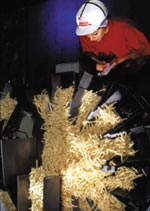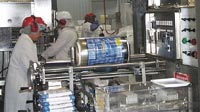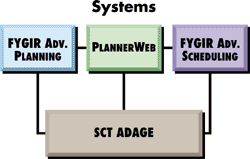
Simplot is a major U.S. manufacturer of potato and vegetable products with plants and partnerships worldwide.
Manufacturing is typically considered the "weak link" in the supply chain because it lacks internal process integration and has few connections forward to customers and the business-to-business (B2B) world. Future supply-chain initiatives are driven by demand from manufacturing rather than supply to manufacturing, Friend observed.
The manufacturing "time horizon" typically stretches from forecasting in months -- even years -- at the ERP (Enterprise Requirements Planning) level; to production planning in weeks at the ERP and MES (Manufacturing Execution System) levels; to production scheduling in days and shifts at the ERP and MES levels; to executing in hours and minutes with real-time data acquisition in seconds at the plant-floor level.
To execute its manufacturing plan, the plant must integrate finite scheduling; material-requirements planning (MRP); inventory, receiving and issuing operations; personnel-resource planning; purchasing; maintenance; production costing; and customer-order management. To respond quickly to customer orders, "production scheduling could be the place to start integrating manufacturing with the supply chain -- integrating the master production plan with MRP and B2B web commerce at the supplier end, and with sales forecasting and B2B web commerce at the customer end," said Friend.
Small food manufacturers with a single plant, relatively few SKUs and a simple customer profile need not invest in scheduling software, he continued. But for large companies with multiple plants, a diverse product mix, many SKUs, intermediate products, outsourced functions (such as co-packing), and a complex customer profile, "the whole idea of software is to make complexity simple." As major manufacturers move toward vendor-managed inventories and continuous replenishment "the forecast time frame is collapsing," Friend observed. "The movement becomes the forecast. Central planning cannot effectively optimize production lines -- there are too many decisions to be made too quickly, and plants don't have enough time to react and make the right decisions. So the key is to link forecasting to scheduling in some way."

Scheduling as 'competitive advantage'
In Simplot's architecture, production models in the MES software layer tell a production-capability model what resources are needed to make a particular SKU. The production model specifies the ingredients, materials and line rates needed; the production-capability model combines that information with inventory, sales forecast and plant-capacity information and sends the results to a master production schedule, which in turn determines the weekly line-load schedule for the plant. The models are continually updated to reflect variables such as seasonality and yields.Line-loading can mean a cultural shift for the plant, Friend pointed out. It can require a change in mindset from reaction to proaction (planning); from making to customer order rather than to inventory; from spreadsheet to OLAP (on-line analytical processing) server technology; and changes in plant organization, requiring new skill sets.
Friend presented a case study from Simplot, where some vegetable plants are using plant-centric production-scheduling software. Plant architecture integrates Wonderware Factory Suite at the PLC level with Wonderware Protean at the MES level for line-loading, and with Chesapeake MIMI to generate the production-capability model and master production schedule (MPS). SAS Focus Forecast, a forecast editor, adds historical sales data to develop the most probable future scenario, which is modified monthly by sales management and fed into the production-capability model.
But forecasts are always wrong, Friend observed. So he started broadcasting forecasts versus actual sales to the Simplot executive committee and voila! -- the gap started to close. Result: For Simplot's fiscal 2000 first quarter, the gross forecast error was reduced by a factor of 10.
Wonderware's Protean plant-centric ERP solution incorporates a planning and scheduling module which displays relationships between supply and demand. With Protean's planning capability, the user can see how changes to a production schedule will impact supply-chain and customer requirements and adjust accordingly. It allows the user to pause a planned production schedule at different stages and analyze results; resequence a schedule to minimize changeovers; perform finite forward line-loading for constraint-based planning; and quickly change production schedules to solve capacity overloads. Capacity scheduling displays all schedules loaded on a selected piece of equipment; resource scheduling displays all schedules which consume or produce a selected ingredient or packaging resource. Based on these schedules, the module displays what's available-to-promise (ATP) for the customer, recalculates ATP information to reflect changes, and alerts the user to any shortages caused by schedule changes.
After 24 months of moving toward the integrated model, one Simplot frozen-vegetable plant producing 500 SKUs on 12 packaging lines improved MPS compliance from 86 to 99 percent. The number of stock items falling below the target inventory minimum was reduced from an average of 13 to just one.
Rollout of the system last Jan. 1 to a frozen potato-products plant, where the integration team had been in-place for 12 months, will feature a "moving MPS" communicated to suppliers -- part of Simplot's supplier-development process aimed at continuous improvement.
Automated inter-business processes, including the integration of manufacturing across enterprises in the supply chain, are critical to future plant requirements, Friend observed. "Plant scheduling is the place to start," he concluded. "It offers a competitive advantage."

Modeling the 'real world'
Timothy Chambers, director of business process consulting at Basic American Foods, described how manufacturing is integrated into his company's complex supply chain at Food Automation 2000.Basic American, the nation's largest potato dehydrator, operates eight plants producing 350 potato and bean SKUs distributed through its own distribution center and five public warehouses to food-service chains and two major retail/industrial customers. Production-line utilization frequently exceeds 90 percent with multistage processes manufacturing dried, granulated, extruded and agglomerated products to forecast and to stock. Multiple plants make the same first-stage products, but at each stage of production a product may be sold, further processed or transferred to another plant. On-site bulk-storage capacity is limited. Supply-chain considerations include raw-material contracts; production location and consolidation; plant-capacity allocation; distribution evaluation; inventory requirements; product specifications; managed formulas; and by-product sales.
Optimizing the supply chain requires modeling both opportunities and constraints, and solution time must match the business cycle, Chambers pointed out. BAF's architecture integrates SCT Corporation's Fygir Advanced Planning module for modeling and optimizing the plan; SCT's Fygir Advanced Scheduling module for refining schedules; and SCT's Adage, an ERP program with central depository for executing the plan.
The advanced scheduling module at Odom's Tennessee Pride relates hog receiving and slaughtering operations to intermediate and finished-product yields while tracking work-in-progress (WIP), including catchweights. (Sources: Odom's Tennessee Pride; SCT Corp.)
SCT solutions focus on process industries, including food and beverage. The Advanced Planning module makes trade-offs between raw-material costs, production costs and inventory costs to generate a cost-optimized production plan. This means analyzing a wide range of constraints such as labor, energy, transportation and storage availability in all BAF plants and warehouses. The Advanced Scheduling module sequences and schedules each of the many production and packaging operations involved in manufacturing 350-plus SKUs. It minimizes changeover times and schedules limited storage capacities. Schedulers at different BAF facilities across the country have instant access to production plans.
The Fygir planning and scheduling modules "provide a flexible platform for modeling 'real-world' business conditions," said Chambers. The object-oriented structure of the modules permits reuseable components. "Plants can leverage-off savings in other plants through advance planning," he added. PlannerWeb, a tool developed in-house, coordinates data and publishes results to the organization. Models are not the real world, Chambers cautioned, but they can identify optimum solutions without costly experimentation.
It took about nine months to develop the model, said Chambers. When developing such a model, he advised, "emphasize the time spent in design, not development. Otherwise, it will seem like you are accomplishing nothing while frustrating everyone!"
Lessons learned: Establish clear goals; expect that good planning will impact other processes and model designs; understand your business and its drivers. "As prepared as we were, we still underestimated the effort," he recalled.
Chambers concurred with Friend that culture plays a significant role in supply-chain planning. "You need trust and confidence in the individuals driving change," while applying discipline, accountability and results measurement.

The 'organic supply chain'
Chuck Odom, owner and vice-president/information technology of sausage producer Odom's Tennessee Pride, described Odom's supply-chain solution atFood Engineering's PLANTtech 2000 Conference last June.The system integrates the company's headquarters and three manufacturing plants with its hog suppliers, ingredient suppliers, three regional sales offices, 15 third-party distribution centers, and customers in retail and food-service markets.
Food manufacturers have an "organic" rather than a traditional supply chain -- something that many software vendors don't understand, Odom observed. A few examples: The food manufacturer's time components include customer due dates, product shelf life and "best before" dates; the food processor receives raw materials of variable or seasonal quality and manufactures co-products, by-products, scrap and waste, all of which vary end-product yields; commodity prices are unstable, varying profit margins.
Odom's strategy was to reorganize the company for:
- Regulatory compliance with lot tracking of purchased items, work-in-progress and finished goods;
- Capturing and recording catchweights (differing weights of the same product, such as hams and pork loins);
- Cost savings across the supply chain through production planning, production scheduling and more accurate forecasting.
- Improving customer relationships with products and shipments available to promise (ATP) and capable to promise (CTP).
- Applying new tools such as radio-frequency communication, real-time data collection and barcodes.
With implementation assistance from Arthur Andersen, "we broke all the rules" by simultaneously tackling process changes and multiple projects at multiple locations in a 15-month project, Odom reported. Rather than phased implementation, the entire system was rolled out "with a Big Bang," he added, because there were no legacy systems requiring interface -- and because of the company's small (four-person) IT staff.

- Reduced production costs through reduced changeovers and increased asset utilization in kill, cut and packaging operations;
- Visibility to future orders and trends;
- Integrated forecasting, planning and scheduling;
- Reduced inventories across the entire supply chain;
- "Absolute" perpetual inventories, "to the pound;"
- Lot control and tracking "nailed to the wall:"
- Accurate sub-lots and catchweights;
- Improved yields through reduced scrap;
- Optimized warehousing and distribution;
- Increased sales by eliminating out-of-stock conditions;
- Increased customer satisfaction through reduced cycle times.
Cross-border integration
ConAgra Malt Americas, which supplies malt to major brewers, food processors and distillers, has to date installed Wonderware'sProteanERP system to integrate raw-material (barley) procurement, manufacturing and sales in four plants, with the goal of establishing an enterprise-wide system integrating all six of its plants.ConAgra Malt includes Canada Malting in Canada and Great Western Malting in the U.S. The three Canadian plants were formerly automated with a manufacturing package developed in Ingres and running in a VAX environment, while the three Great Western plants ran on a customized AS/400 application. ConAgra Malt's shift to Protean was sparked by the need for Y2K compliance at Great Western, but the real driver was the need for a common corporate database across both countries, said Bruce French, director of malting. Because upgrading its legacy systems proved cost-prohibitive, the company selected Protean as an integrated ERP solution that operated on standard platforms and configurations, was reasonably priced, could be deployed at multiple sites, could be modified to keep pace with changing business conditions, and could be implemented "off the shelf."
ConAgra Malt's Protean system incorporates production, planning, scheduling, inventory control and customer-order management (COM) modules. According to French, ConAgra blends malt products to customer specifications, requiring lot traceability to insure custom specifications and "a unique software solution that could model our multi-stage processes and all its complex scheduling requirements."
As part of the company's plant-centric approach, each malting house has its own variation of the malting process, but Protean enables the company to establish common standards to which all plants must comply. Plants receive a master production-planning schedule created at the corporate level and executed at the plant level. System flexibility allows maltsters to create production schedules accommodating variations in each malt house and malting process, and based on production models for cleaning, malting, blending and shipping operations. The system minimizes scheduling time for production runs and generates cost information to determine product profitability, while the integrated COM module confirms product availability based on constantly-changing demand.
Flexible scheduling
SCT'sFygirAdvanced Scheduling package helps boost flexibility and productivity at Unilever unit Mora, largest snack-food producer in The Netherlands. (Originally developed in The Netherlands,Fygirwas acquired by US-based SCT in 1998.)"Using the package's simulation techniques, we know in advance whether any proposed changes are viable options for us," said Saskia de Theije, production scheduler at Mora. "That enhances flexibility in our scheduling and by extension the service level to our customers."
Installed four years ago, Fygir integrated with Mora's existing logistic information system, which stores all purchasing, inventory and sales data, and generates weekly production targets and purchase orders for raw materials. By using Fygir Advanced Scheduling, schedulers can make optimum use of production resources and generate an overview of how people, materials, equipment and storage facilities can be employed at least cost. This improves not only short-term scheduling accuracy but the reliability of long-term materials requirements and capacity planning, says de Theije.
"Fygir...shows us at a glance where we have excess capacity," she added. "Bottlenecks such as freeze tunnels can be managed more effectively. We're able to make rapid simulations of various alternative schedules and discuss our options with the work floor."
Along with other factors, including increased consumer demand, de Theije credited Fygir Advanced Scheduling with helping boost Mora's man-hour productivity by 5 percent, production volume by 6 percent and line efficiency by 6 percent after one year of system implementation in 1998.